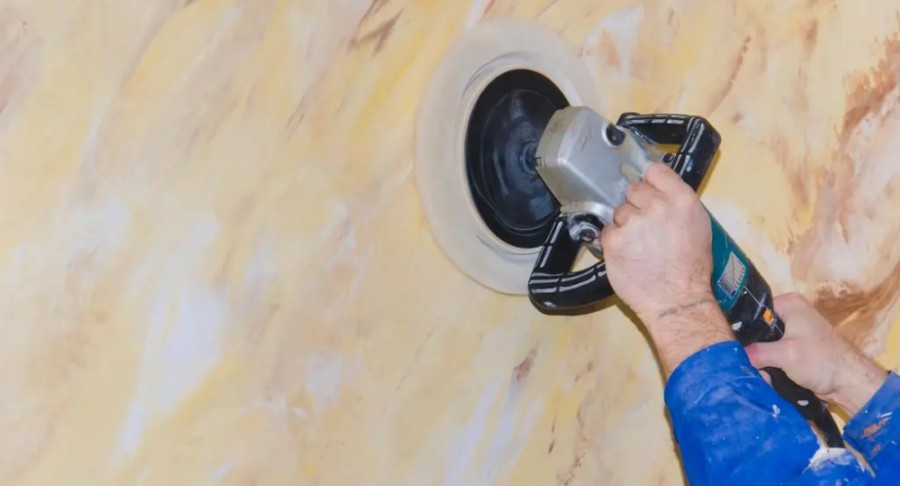
Achieving the Perfect Wall Finish
Achieving a smooth and perfectly level finish can be a challenge for wall stone construction. Unlike floor stone, which can be easily processed with a heavy-duty grinder, wall stone requires specialized grinding and leveling techniques. In this article, we discuss the limitations of hand polishers and explore effective techniques to achieve the perfect wall finish for impeccable decorative results. Knowing about these technologies will greatly help the communication between the owner and the construction party.
If you want to use a hand polishing machine + dry polishing pad to grind the walls and countertops to a good effect, the key elements focus on the following points:
1. Material selection (abrasives)
It is used with dry polishing pad for hand polishers. These discs come in regular sizes of 3 inches and 4 inches and are available in a variety of grit sizes such as 50#, 100#, 200#, 400#, 800#, 1500#, and 3000#. These numbers indicate the coarseness or fineness of the grit on the disc. The grinding process with these discs involves first smoothing the surface with coarser grits and then progressively polishing with finer grits. The number of segments on the disc may vary, but there is usually a correspondence between numbered grit and segments. The manufacturing process of dry grinding discs is mature, and the grinding discs on the market are of good quality. However, it is still important to start grinding with the proper grit size based on the reality of the surface you are machining. This helps to achieve optimum leveling and polishing. Note that wall sanding with these discs still requires physical strength and skill.
Depending on the condition of the surface you are working on, it is really important to start grinding with the proper grit. When there are major concerns such as leveling differences, severe scratches, or surface damage such as aging, chalking, or contamination, it is recommended to start with a coarser grit such as 50#. Using a coarser grit allows for deep cuts and helps to tackle these basic problems effectively. Failure to resolve these issues with a coarse grain may result in incomplete resolution of level differences and local defects. These issues can be difficult to resolve in subsequent polishing stages and may not be fully resolved. But if these problems do not exist and the surface condition is good, you can start to use finer particle sizes according to the actual situation of the surface, such as 100#, 200#, or even 400#. This method allows for a smoother transition from grinding to polishing. Remember to carefully evaluate the surface before selecting the appropriate starting abrasive to ensure the best results from your grinding process.

2. Choice of pressure
Regarding the downforce that the arm needs to generate during the operation of the hand throwing machine, there are following points:
a. Strength level
Achieving superior grinding and polishing results in the stone care industry requires an understanding of the importance of downforce. While measuring downforce in real-time during a grinding operation can be challenging, there are effective ways to determine the proper intensity required.
Downforce comparison: using crystalline powder as a reference: A reliable way for workers to estimate the downforce required during grinding is to compare it to the force required to move a bucket of crystallized powder, which typically weighs about 5kg. By knowing the arm strength required for this task, the operator can measure the downforce required during the polishing process.
Recommended grinding and leveling pressure levels: For ideal results, we recommend maintaining a pressure range of 10-20 kg when sanding and leveling. During the grinding optimization phase, a pressure of about 10 kg can be used. When the process transitions to the grinding and polishing stages, a pressure range of 5-10 kg is sufficient. Adherence to these pressure standards will ensure that the grinding disc will work effectively on the stone surface to achieve the desired results.
Ways to avoid perfunctory: Unfortunately, many people tend to take a perfunctory attitude when it comes to grinding operations. It's important to understand that simply rubbing against walls and countertops without applying the required downforce can compromise the effectiveness of the grinding process. It is worth noting that when operating a grinder or facing machine on the ground, these machines have a natural downforce due to gravity. Failure to recognize the importance of proper downforce can prevent optimal results from being achieved.
b. Uniform force
Although a pressure range of 5-20 kg is provided, it must be understood that this range should not be used indiscriminately. Instead, it should be used as a guide to ensure consistent and controlled strength throughout the grind. A common observation is that some people tend to grind from a position very close to the body, leading to excessive stress in the initial stages. This inconsistency in pressure distribution can result in uneven cuts and insufficient material removal by the disc. Therefore, it may cause local height differences and in some cases even scratches. To solve this problem, workers are encouraged to improve their operating skills. Regardless of the field being studied, it is critical to apply even pressure to ensure consistent results. However, it is important to note that the measured pressure increase is acceptable if a local height difference (such as a notch) is encountered.
Those skilled in the art understand that this adjustment does not contradict the fundamental principle of maintaining force uniformity. As an illustration, let us assume that a worker is used to applying a pressure of 10 kg during the leveling phase. When encountering a height difference, such as a notch, it is reasonable for them to increase the pressure to 15kg or even 20kg in that particular area. Once the surface becomes smooth, it is recommended to return to the original pressure of about 10 kg. This approach ensures an efficient, comprehensive grinding process, minimizing any unwanted irregularities. The key takeaway here is that precision and consistency are essential to mastering the art of grinding. Skilled workers realize the importance of even application of force and make targeted adjustments when necessary. By adhering to these principles, they achieved remarkable results while maintaining the integrity of the objects they were dealing with.
c. Move evenly
In addition, the moving speed should be uniform during polishing, neither too fast nor too slow.For the specific speed, you can refer to mature experience, or you can refer to your own speed when grinding the ground.

-
Online service
-
Official wechat
account
-
QQ:40933769
-
E-mail:
sales@z-lion.com
Online service
Please feel free to give your inquiry in the form below. We will reply you in 24 hours.

